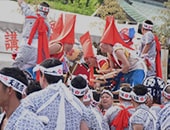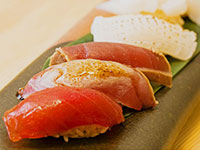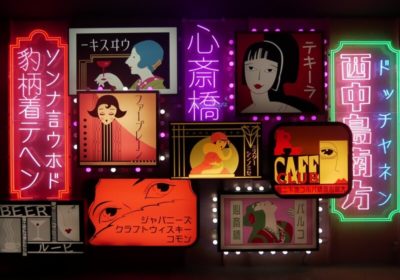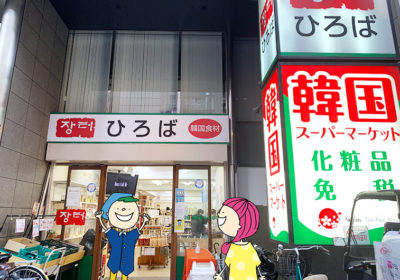

Osaka Bob FAMILY
Kushikatsu? Kushiage? No Double-dipping? Everything You Need to Know about Kushikatsu and Then Some!
Maido! This is Manabu, from Bob Family!
Today, I wanted to share with you the best things about one of Osaka’s signature dishes—kushikatsu—so I spoke the Japan Kushikatsu Association. Did you know there is a Japan Kushikatsu Association?!? Anyway, with our forces combined, we are going to tell you everything you need to know about Kushikatsu, including its history, how to eat it, and the rules. Yes, rules! When we talk kushikatsu, we are not talking manners…We are talking rules!
(Contents)
- What is Kushikatsu, This Piping Hot Dish Originating in Osaka’s Shinsekai Area?
- What’s the Difference Between “Kushikatsu” and “Kushiage”?
- The Reason Behind the Double-dipping Rule
- September 4 is Kushikatsu Memorial Day! Let’s Celebrate with Kushikatsu!
- Sharing Kushikatsu with the World—Recruiting Apprentices from Overseas
●What is Kushikatsu, This Piping Hot Dish Originating in Osaka’s Shinsekai Area?
Meat, vegetables, and seafood wrapped in crispy batter, that is kushikatsu.
Once you dip it in the sauce and take a bite, you’ll definitely fall in love with kushikatsu♡ That’s why we Osakans love kushikatsu and we want you to try it too!

Kushikatsu comes from Shinsekai, the area around Tsutenkaku Tower. According to most accounts, the dish was created about 100 years ago. There were many laborers in Shinsekai who needed a quick bite to eat at a reasonable price. And to satisfy the demand, people started dipping pieces of beef in batter and then deep-frying it. That is the origin of kushikatsu!
These cheap, thickly battered beef skewers satisfy the stomach and they are so easy to eat since you just dip them in sauce from a jar or tray. This is the perfect for Osakans since we are impatient, but also love food.
Kushikatsu became very popular and eventually large restaurants started skewering all sorts of vegetables, seafood, and other foods to deep-fry. Because of this history, the Japan Kushikatsu Association has designated Shinsekai as the “sacred place for kushikatsu.”

I’ve never counted them properly, but there are apparently between 300 and 400 kushikatsu restaurants in Shinsekai alone. It’s true that when you go to Shinsekai, you’ll notice there are a lot of kushikatsu restaurants!
●What’s the Difference Between “Kushikatsu” and “Kushiage”?
In Osaka, we say, “kushikatsu,” but in Tokyo and other parts of the Kanto region, many people call it “kushiage.”
In contrast to Kansai-style kushikatsu, where there is one ingredient per skewer, the kushiage-style often uses multiple ingredients on one skewer, like a combination of meat and vegetables.

General differences between Kushikatsu and Kushiage:
| Kushikatsu | Kushiage | |
|---|---|---|
| Region | Primarily Osaka and the greater Kansai region | Tokyo and Kanto area |
| Ingredients | One ingredient per skewer | Multiple ingredients on one skewer |
| Breading | Thick | Thin |
| Sauce | Worcestershire sauce based | Varies depending on skewer ingredients |
| Preparation method | Varies depending on skewer ingredients | Coated in panko bread crumbs and deep-fried |
However, these are generalizations, and opinions seem to vary person to person.
Some people think that kushikatsu are only skewered meat, and they consider anything else to be kushiage.
Although there are general differences between the two, they both share a common theme: deep-fried food on a skewer. That’s why I think it doesn’t matter too much what you call it, as long as I can eat it.
For example, would you call fried chicken on a skewer “kushikatsu”?
When I checked with the Japan Kushikatsu Association, they said, “Sure, it’s OK to call that kushikatsu.”
Me: What about fried corn dogs?
Them: Yes, those are kushikatsu.
Me: How about fried takoyaki on a skewer?
Them: It’s takoyaki, but it’s also kushikatsu!
Me: Really!?
Them: Don’t you think? After all, they are all fried!
The Japan Kushikatsu Association, is surprisingly accepting. How very on brand for Osaka!
●The Reason Behind the Double-dipping Rule
So you’ve heard about the “no double-dipping rule” right? I think everyone knows, but they talk about it so much, I want to make sure.
At kushikatsu restaurants, there’s usually a container of sauce on the table. And customers share the container, so it’s obviously a problem if you dip a half-eaten skewer in there. That’s it—that’s the rule!

I’ve seen someone get in trouble with the restaurant for dipping a half-eaten skewer in the sauce. Apparently, they didn’t know about this rule…
So why do you think this rule exists?
Well, it’s because it’s not hygienic to dip your something your mouth has touched into a shared sauce.
Plus, introducing saliva into the sauce on half-eaten skewers can cause it to spoil.
If everyone follows the rule, we can all comfortably enjoy Kushikatsu, the way it is supposed to be eaten. Does that make sense?
By the way, the Japan Kushikatsu Association has set forth the following K2K Rules* for eating kushikatsu.
*K2K is an acronym for Kushikatsu 2dozuke Kinshi. Translation: Double-dipping kushikatsu is prohibited.
K2K Rules:

- First, you must wash/sterilize your hands
- You must only dip your kushikatsu in the shared sauce 1 time
- Once you have dipped your kushikatsu, you must place it your own plate (some sauce will pool on your plate at this point)
- Salt or other seasonings must only be applied to kushikatsu on your own plate, not the tray
- You must not contaminate the sauce
- You must eat your kushikatsu while it is still hot
- You must place your skewers in the designated holder after eating your kushikatsu
- You must teach others who do not know the rules of kushikatsu eating in a kind manner
Some people think the ban on double-dipping is annoying or too troublesome. And recently a number of kushikatsu restaurants have stopped using shared sauces altogether.
But the no double-dipping of kushikatsu rules are a part of the food culture that has been cultivated here in Osaka. Essentially, eating kushikatsu according to the rules is a unique cultural experience.
So, if you visit a kushikatsu restaurant in Osaka, I hope you can enjoy this dish and the rules that go along with it.
By the way, when I asked a cook how much sauce should be applied to the kushikatsu, they recommended dipping it 70-80% into the sauce. This way you can taste the parts of the batter that aren’t covered in sauce, which apparently brings out the flavor of what’s inside!
●September 4 is Kushikatsu Memorial Day! Let’s Celebrate with Kushikatsu!
The Japan Kushikatsu Association is striving to protect the culture of kushikatsu and to revitalize the kushikatsu industry, with initiatives like re-establishing the rules against double dipping.
One of the other accomplishments is the establishment of Kushikatsu Memorial Day.
In recognizing September 4 (which can be read kushi in Japanese) as a special day, both kushikatsu chefs and kushikatsu fans are encouraged to make the day wonderful with kushikatsu. Restaurants that support the association celebrate with different events, so be sure to look for them on the Japan Kushikatsu Association website!
https://japan-kushikatsu.jp/kinenbi.html
Oh, and they’ve also created a kushikatsu fairies called Kushi-Nyoro to sprinkle a little more magic and energy into the kushikatsu industry.

Kushi-Nyoro are fairies are like spirits that live inside kushikatsu and only appear when kushikatsu are deep-fried and have been prepared with lots of love. The creatures can only be seen by people who love kushikatsu, and they bring tremendous luck to those who see them.
Kushi-Nyoro are fairies of good fortune who can bring business prosperity and sterilize bad bacteria at the same time. Can everyone see them?

Here you can see the Kushi-Nyoro smartphone cases made by the Japan Kushikatsu Association.
You can buy them through the URL listed below, so have a look!
https://caseplay.shop/collections/kushinyoro?utm_source=referral&utm_medium=hp&utm_campaign=kushinyoro
●Sharing Kushikatsu with the World—Recruiting Apprentices from Overseas
Furthermore, the Japan Kushikatsu Association is recruiting cooks from overseas to help spread the word even further about how good kushikatsu is. Kushikatsu is Osaka, or rather Japan’s comfort food and one of its most beloved dishes and they want everyone to know!
They are recruiting chefs who are already active as professionals, and also people who are thinking about learning the art of kushikatsu to start out on their own. Japan Kushikatsu Association will teach them how to make a kushikatsu hybrid, which combines the latest cooking utensils, the association’s technical know-how, and Japan’s chemistry-based knowledge.
Hybrid kushikatsu techniques actually decrease oil absorption and improve the overall taste by using quality oil that leads to changes at the molecular level. In other words, this kushikatsu is healthy and delicious!
If this sounds like something you’d be interested in, check out the details here.
https://japan-kushikatsu.jp/about_injapan.html
That’s all I have to say about kushikatsu for now.
Anyway, the interview with Japan Kushikatsu Association was very informative and I learned a lot more about kushikatsu than I expected.

Kushikatsu is a dish where each person can choose their favorite ingredients and eat without worrying about the other person. You can change the seasonings to your liking, and it’s a fun dish where you can create different flavors even with the same ingredients by changing the seasonings.
It is also easy to eat with people you meet for the first time without hesitation.
Now, not only Japanese people, but also everyone visiting Japan from overseas, let’s eat delicious Kushikatsu and be happy today and tomorrow!

Osaka Bob FAMILY
The contents of this page were current at the time it was posted, but may differ from the present.
Text visible in this map is based on information from Map Tiler and may differ from actual geographical names.












































